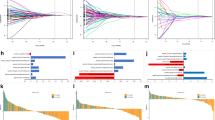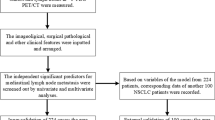Abstract
Objectives
This study aimed to establish a radiomics model based on 18F-FDG PET/CT images to predict visceral pleural invasion (VPI) of solid lung adenocarcinoma preoperatively.
Methods
We retrospectively enrolled 165 solid lung adenocarcinoma patients confirmed by histopathology with 18F-FDG PET/CT images. Patients were divided into training and validation at a ratio of 0.7. To find significant VPI predictors, we collected clinicopathological information and metabolic parameters measured from PET/CT images. Three-dimensional (3D) radiomics features were extracted from each PET and CT volume of interest (VOI). Receiver operating characteristic (ROC) curve was performed to determine the performance of the model. Accuracy, sensitivity, specificity and area under curve (AUC) were calculated. Finally, their performance was evaluated by concordance index (C-index) and decision curve analysis (DCA) in training and validation cohorts.
Results
165 patients were divided into training cohort (n = 116) and validation cohort (n = 49). Multivariate analysis showed that histology grade, maximum standardized uptake value (SUVmax), distance from the lesion to the pleura (DLP) and the radiomics features had statistically significant differences between patients with and without VPI (P < 0.05). A nomogram was developed based on the logistic regression method. The accuracy of ROC curve analysis of this model was 75.86% in the training cohort (AUC: 0.867; C-index: 0.867; sensitivity: 0.694; specificity: 0.889) and the accuracy rate in validation cohort was 71.55% (AUC: 0.889; C-index: 0.819; sensitivity: 0.654; specificity: 0.739).
Conclusions
A PET/CT-based radiomics model was developed with SUVmax, histology grade, DLP, and radiomics features. It can be easily used for individualized VPI prediction.






Similar content being viewed by others
Data availability
The datasets generated during and/or analyzed during the current study are available from the corresponding author upon reasonable request.
References
Kuriyama K, Yanagawa M. CT diagnosis of lung adenocarcinoma: radiologic-pathologic correlation and growth rate. Radiology. 2020;297(1):199–200.
Nagano H, Takumi K, Nakajo M, Fukukura Y, Kumagae Y, Jinguji M, et al. Dual-Energy CT-derived electron density for diagnosing metastatic mediastinal lymph nodes in non-small cell lung cancer: comparison with conventional CT and FDG PET/CT findings. AJR Am J Roentgenol. 2022;218(1):66–74.
Denisenko T, Budkevich I, Zhivotovsky B. Cell death-based treatment of lung adenocarcinoma. Cell Death Dis. 2018;9(2):117.
Masiuk M, Waloszczyk P, Lewandowska M, Dobak E, Urasinska E. Nucleolin and nucleophosmin expression patterns in pulmonary adenocarcinoma invading the pleura and in pleural malignant mesothelioma. Thorac Cancer. 2020;11(9):2529–35.
Huang H, Wang T, Hu B, Pan C. Visceral pleural invasion remains a size-independent prognostic factor in stage I non-small cell lung cancer. Ann Thorac Surg. 2015;99(4):1130–9.
Lakha S, Gomez J, Flores R, Wisnivesky J. Prognostic significance of visceral pleural involvement in early-stage lung cancer. Chest. 2014;146(6):1619–26.
Inoue M, Minami M, Shiono H, Sawabata N, Ideguchi K, Okumura M. Clinicopathologic study of resected, peripheral, small-sized, non-small cell lung cancer tumors of 2 cm or less in diameter: pleural invasion and increase of serum carcinoembryonic antigen level as predictors of nodal involvement. J Thorac Cardiovasc Surg. 2006;131(5):988–93.
Neri S, Menju T, Sowa T, Yutaka Y, Nakajima D, Hamaji M, et al. Prognostic impact of microscopic vessel invasion and visceral pleural invasion and their correlations with epithelial-mesenchymal transition, cancer stemness, and treatment failure in lung adenocarcinoma. Lung Cancer. 2019;128:13–9.
Travis WD, Brambilla E, Rami-Porta R, Vallieres E, Tsuboi M, Rusch V, et al. Visceral pleural invasion: pathologic criteria and use of elastic stains: proposal for the 7th edition of the TNM classification for lung cancer. J Thorac Oncol. 2008;3(12):1384–90.
Choi H, Kim H, Hong W, Park J, Hwang EJ, Park CM, et al. Prediction of visceral pleural invasion in lung cancer on CT: deep learning model achieves a radiologist-level performance with adaptive sensitivity and specificity to clinical needs. Eur Radiol. 2021;31(5):2866–76.
Iizuka S, Kawase A, Oiwa H, Ema T, Shiiya N, Funai K. A risk scoring system for predicting visceral pleural invasion in non-small lung cancer patients. Gen Thorac Cardiovasc Surg. 2019;67(10):876–9.
Lopez Guerra J, Gomez D, Lin S, Levy L, Zhuang Y, Komaki R, et al. Risk factors for local and regional recurrence in patients with resected N0–N1 non-small-cell lung cancer, with implications for patient selection for adjuvant radiation therapy. Ann Oncol: official journal of the European Society for Medical Oncology. 2013;24(1):67–74.
Butnor K, Cooper K. Visceral pleural invasion in lung cancer: recognizing histologic parameters that impact staging and prognosis. Adv Anat Pathol. 2005;12(1):1–6.
Rami-Porta R, Bolejack V, Crowley J, Ball D, Kim J, Lyons G, et al. The IASLC lung cancer staging project: proposals for the revisions of the T descriptors in the forthcoming eighth edition of the TNM classification for lung cancer. J Thorac Oncol. 2015;10(7):990–1003.
Zhang T, Zhang JT, Li WF, Lin JT, Liu SY, Yan HH, et al. Visceral pleural invasion in T1 tumors (</=3 cm), particularly T1a, in the eighth tumor-node-metastasis classification system for non-small cell lung cancer: a population-based study. J Thorac Dis. 2019;11(7):2754–62.
Muraoka M, Akamine S, Oka T, Tagawa T, Nakamura A, Tsuchiya T, et al. Sentinel node sampling limits lymphadenectomy in stage I non-small cell lung cancer. Eur J Cardiothorac Surg. 2007;32(2):356–61.
Kim H, Goo JM, Kim YT, Park CM. CT-defined visceral pleural invasion in T1 lung adenocarcinoma: lack of relationship to disease-free survival. Radiology. 2019;292(3):741–9.
Farsad M. FDG PET/CT in the staging of lung cancer. Curr Radiopharm. 2020;13(3):195–203.
Wang L, Li T, Hong J, Zhang M, Ouyang M, Zheng X, et al. (18)F-FDG PET-based radiomics model for predicting occult lymph node metastasis in clinical N0 solid lung adenocarcinoma. Quant Imaging Med Surg. 2021;11(1):215–25.
Han Y, Ma Y, Wu Z, Zhang F, Zheng D, Liu X, et al. Histologic subtype classification of non-small cell lung cancer using PET/CT images. Eur J Nucl Med Mol Imaging. 2021;48(2):350–60.
Tanaka T, Shinya T, Sato S, Mitsuhashi T, Ichimura K, Soh J, et al. Predicting pleural invasion using HRCT and 18F-FDG PET/CT in lung adenocarcinoma with pleural contact. Ann Nucl Med. 2015;29(9):757–65.
Mayerhoefer ME, Materka A, Langs G, Haggstrom I, Szczypinski P, Gibbs P, et al. Introduction to Radiomics. J Nucl Med. 2020;61(4):488–95.
Yip SS, Aerts HJ. Applications and limitations of radiomics. Phys Med Biol. 2016;61(13):R150–66.
Ji G, Zhu F, Zhang Y, Liu X, Wu F, Wang K, et al. A radiomics approach to predict lymph node metastasis and clinical outcome of intrahepatic cholangiocarcinoma. Eur Radiol. 2019;29(7):3725–35.
Tan Y, Zhang S, Wei J, Dong D, Wang X, Yang G, et al. A radiomics nomogram may improve the prediction of IDH genotype for astrocytoma before surgery. Eur Radiol. 2019;29(7):3325–37.
Iasonos A, Schrag D, Raj GV, Panageas KS. How to build and interpret a nomogram for cancer prognosis. J Clin Oncol. 2008;26(8):1364–70.
Chen Z, Jiang S, Li Z, Rao L, Zhang X. Clinical value of (18)F-FDG PET/CT in prediction of visceral pleural invasion of subsolid nodule stage I lung adenocarcinoma. Acad Radiol. 2020;27(12):1691–9.
Shimizu K, Yoshida J, Nagai K, Nishimura M, Ishii G, Morishita Y, et al. Visceral pleural invasion is an invasive and aggressive indicator of non-small cell lung cancer. J Thorac Cardiovasc Surg. 2005;130(1):160–5.
Kawase A, Yoshida J, Miyaoka E, Asamura H, Fujii Y, Nakanishi Y, et al. Visceral pleural invasion classification in non-small-cell lung cancer in the 7th edition of the tumor, node, metastasis classification for lung cancer: validation analysis based on a large-scale nationwide database. J Thorac Oncol. 2013;8(5):606–11.
Takizawa H, Kondo K, Kawakita N, Tsuboi M, Toba H, Kajiura K, et al. Autofluorescence for the diagnosis of visceral pleural invasion in non-small-cell lung cancer. Eur J Cardiothorac Surg. 2018;53(5):987–92.
Zhong C, Fang W, Mao T, Yao F, Chen W, Hu D. Comparison of thoracoscopic segmentectomy and thoracoscopic lobectomy for small-sized stage IA lung cancer. Ann Thorac Surg. 2012;94(2):362–7.
Snoeckx A. Visceral pleural invasion: predictable on CT? Quant Imaging Med Surg. 2019;9(12):2019–22.
Zhao Q, Wang JW, Yang L, Xue LY, Lu WW. CT diagnosis of pleural and stromal invasion in malignant subpleural pure ground-glass nodules: an exploratory study. Eur Radiol. 2019;29(1):279–86.
Rami-Porta R, Asamura H, Travis WD, Rusch VW. Lung cancer - major changes in the American Joint Committee on Cancer eighth edition cancer staging manual. CA Cancer J Clin. 2017;67(2):138–55.
Author information
Authors and Affiliations
Corresponding author
Ethics declarations
Conflict of interest
The authors declare that they have no conflict of interest.
Additional information
Publisher's Note
Springer Nature remains neutral with regard to jurisdictional claims in published maps and institutional affiliations.
Rights and permissions
Springer Nature or its licensor (e.g. a society or other partner) holds exclusive rights to this article under a publishing agreement with the author(s) or other rightsholder(s); author self-archiving of the accepted manuscript version of this article is solely governed by the terms of such publishing agreement and applicable law.
About this article
Cite this article
Cui, N., Li, J., Jiang, Z. et al. Development and validation of 18F-FDG PET/CT radiomics-based nomogram to predict visceral pleural invasion in solid lung adenocarcinoma. Ann Nucl Med 37, 605–617 (2023). https://doi.org/10.1007/s12149-023-01861-w
Received:
Accepted:
Published:
Issue Date:
DOI: https://doi.org/10.1007/s12149-023-01861-w




